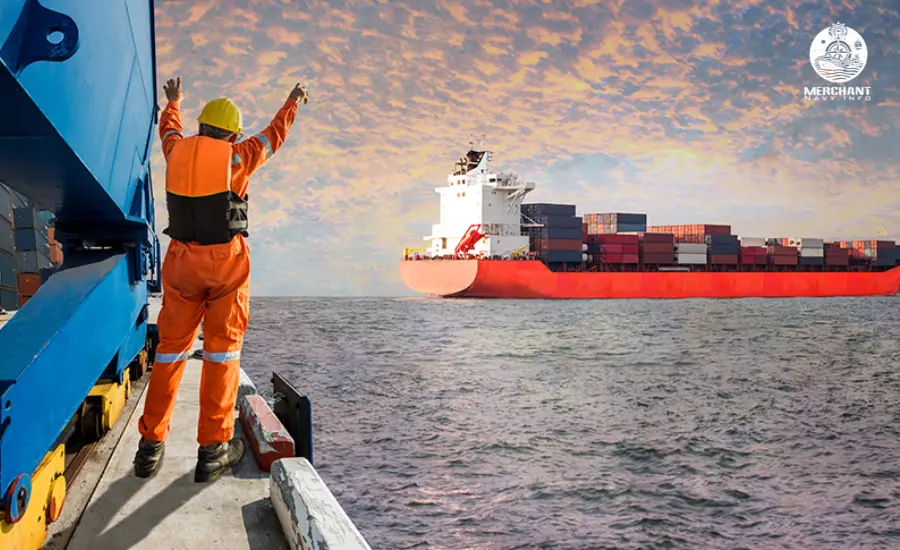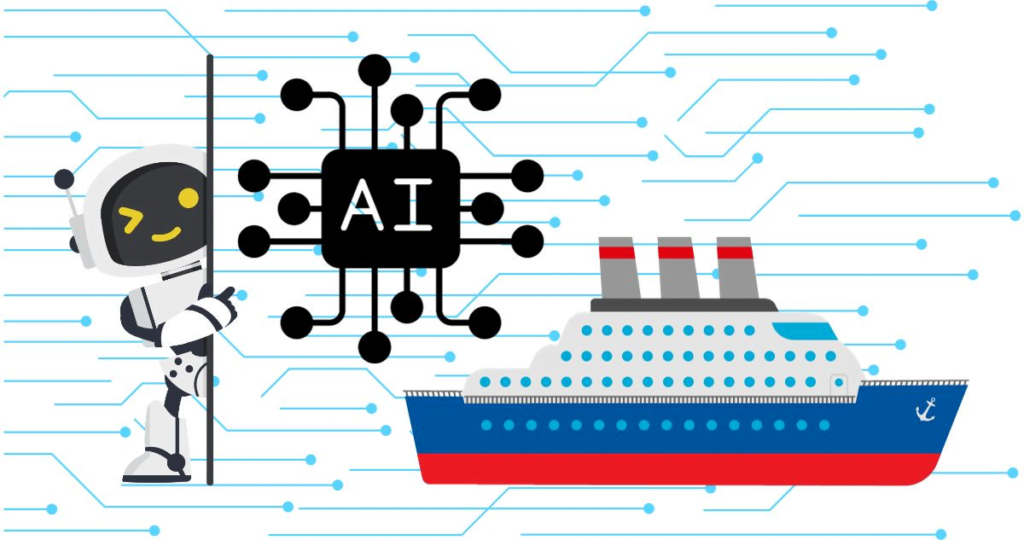
Supply and demand imbalances, environmental regulations, and lack of skilled labor are major challenges in the maritime industry trends. Future maritime industry trends will have minimal impact on ship operations. The transition to cleaner energy sources and energy-efficient integration are reducing the industry’s environmental impact.
Artificial intelligence (AI), big data and analytics, Internet of Things (IoT), robotics, and blockchain are being used in various fields to improve operational efficiency. Also, immersive reality advances such as increased reality and virtual reality have a specific focus on preparation, building, and assessment. This report was distributed in February 2022 and upgraded in February 2024.
Top 10 Maritime Industry Trends in 2024

1. Artificial Intelligence
In the maritime industry trends, artificial intelligence is used for predictive maintenance, autonomous navigation, and route optimization. The primary role of AI is to process large-scale sensor data, public information systems, and asset tracking to generate actionable insights. By leveraging this information, startups can improve predictive accuracy and optimize fuel efficiency, maintenance, and operating costs. The role of AI will also extend to underwater robots and vehicles that support search and rescue operations and underwater repairs. AI-powered digital twins enable continuous monitoring of ports, ships, and fleets, improving ship and port management. Additionally, AI can improve safety by analyzing past accident data and enabling better risk management strategies.
2. Clean Energy
Maritime operations, primarily fueled by heavy fuel oil (HFO), contribute significantly to emissions. Decarbonizing shipping requires a transition to low-carbon renewable energy sources. Electric drive technologies, biofuels, wind energy, solar energy and hydrogen are becoming increasingly important. Startups are emerging to develop equipment to electrify boats. Major shipping companies are introducing low-carbon fuels to their ships, and biofuels offer an economical low-carbon alternative to HFO without structural upgrades. Electric propulsion and hydrogen propulsion are trending as they significantly reduce emissions without impacting ship productivity. A key step in this green transition is the introduction of liquefied natural gas (LNG) as a cleaner fuel option.
3. Marine Robotics
Labor shortages and the safety of the marine environment are pressing issues. Startups are tackling these problems by developing maritime robotics solutions using AI and advanced hardware. Robots designed for maintenance, cleaning, rescue and inspection at sea are becoming increasingly popular. These include automated robots with special arms and hardware systems for underwater maintenance tasks. Drones are also used in ports and ships for inspections and food deliveries in maritime industry trends. These automated arrangements not only fill work crevices but also decrease presentation to perilous conditions amid upkeep and assessment assignments.
Additionally, these robotic systems collect important data about ocean health and contribute to conservation efforts. Alicia Bots develops multi-purpose robots. US-based startup Alicia Bots develops multi-purpose robots for cleaning and maintenance of ships. The startup’s robot, RoverClean 1.0, operates in both remote-controlled and autonomous modes to remove sludge from tanks, detect corrosion, polish propellers, and clean ship hulls. Also, Roverclean 1.0 underpins repairs, assessments, and information collection. This permits vessel administrators and upkeep groups to extend body flexibility and decrease biofouling, which results in expanded fuel proficiency. The robot operates underwater, so worker safety is not compromised.
4. Energy-Efficient Integration
Shipping companies rely on energy-efficient integration to reduce greenhouse gas emissions and fuel costs. This includes improvements to various ship systems such as scrubbers, rudders, lubrication, coatings and propulsion systems. Startups are venturing into waste heat recovery solutions and innovations in ship and exhaust design. These additions will significantly improve the sustainability of oceanic operations while lessening vitality and fuel costs. Progressed frame plans and coatings are too utilized to decrease drag, coming about in lower fuel necessities for the vessel.
5. Maritime IoT
Continuous monitoring of a vessel’s position is critical in maritime operations, as it reduces the risk of collision and aids navigation in difficult weather conditions. IoT integration simplifies data collection and tracking of emissions, machine health, propulsion data, and structural integrity. This gives transportation companies detailed insight into their processes and assets, allowing them to quickly identify bottlenecks and prevent downtime. Additionally, IoT can also help with regulatory compliance by providing accurate data for environmental reporting.
Wattson Elements builds connected ports. Wattson Elements is a French startup offering his FALCO, a range of IoT solutions for boats. The startup’s IoT device enables boat location monitoring and socket management. The FALCO cloud platform uses this data to enable real-time monitoring and identification of boats, enabling detection of berth occupancy, fire, robbery, and theft. This enables port agents to create a connected ecosystem, improve visibility into port operations, and facilitate data-driven decision-making.
6. Blockchain
Manual data recording systems are time-consuming and susceptible to forgery. This leads to a lack of trust between shipping companies, shipowners, vessel operators and ports, impacting overall productivity. Blockchain technology counters this by providing transparent and tamper-proof data storage, ensuring data integrity and transparency in transactions and financial operations. Startups are developing blockchain solutions such as payment systems, automated documentation platforms, and maritime-specific smart contracts.
This transparency in the maritime industry trends value chain ensures smooth operations with tamper-free data and communication flows. Marified offers electronic passports for seafarers Singapore startup Marified offers electronic passports for seafarers. The startup’s blockchain-based platform allows users to publish, store, manage, and verify documents. By storing documents on the blockchain, authorities can ensure that forgery is prevented. This allows transport administration companies, preparing centers and seafarers to extend effectiveness and decrease costs related to report handling while making strides in the security of life in the ocean.
7. Big Data And Analytics
The maritime industry trends are witnessing a significant increase in data from IoT devices and satellites. This increases the amount of data available for processing and provides valuable insights into ships and ports. The raw data is analyzed by big data, and important information is extracted. Advanced analytics solutions leverage this data and generate actionable insights. These insights can be applied to route management, monitoring weather conditions, analyzing freight patterns, and operational analysis. This allows transportation companies to streamline operations, identify potential bottlenecks before they occur, and minimize downtime and costs. Additionally, dynamic pricing models for delivery services benefit from real-time data analysis and improve market responsiveness.
8. Immersive Reality
Traditional maritime education and training often do not provide practical experience before operators are sent to sea, reducing seafarer performance.
Task-specific information during maintenance or training operations is provided through augmented reality and mixed reality solutions. For example, VR allows for immersive simulation of tasks onboard ships, allowing for more effective training. Immersive technology extends its reach beyond operator training. It is used in areas such as remote control, maintenance, inspection, marine engineering, and design of ships and submarines. Remotely operated vehicles (ROVs) operate at extreme depths beyond the reach of divers, enriching ocean research. Immersive visualization of this data helps shipyards optimize ship designs and accelerate parts and ship manufacturing. Also, AR overlays digital information onto physical components during maintenance and repair, simplifying complex tasks.
9. 5g Integrating
IoT in offshore communication networks increases the network load on the connectivity infrastructure. Real-time information is becoming important for data-driven process planning to prevent disruptions in maritime operations. To address these concerns, 5G provides a network system that can process large amounts of IoT data with low latency. This significantly optimizes harbor operations and dispatch activity administration. 5G does not only handle information activity but also empowers inaccessible operations such as look and protect operations. In port operations, 5G will improve cargo handling and tracking efficiency and reduce turnaround times.
10. Cybersecurity
The move to advanced instruments is uncovering sea operations to cyber dangers. Vulnerabilities in systems and associated gadgets ended up being targets for malevolent programmers. These cyberattacks compromise confidential information and system controls, resulting in reputational damage and increased legal costs. Startups are tackling this problem by developing cybersecurity solutions tailored to the marine environment. As interest in autonomous ships, IoT, and data analytics increases, these solutions ensure operational stability. Integrating encryption and secure access controls is critical to maintaining confidentiality in shipping operations.
Conclusion
The innovative maritime industry trends described in this report only scratch the surface of trends identified during the data-driven innovation and startup discovery process. Identifying new opportunities and new technologies to introduce into your business can go a long way in gaining a competitive advantage.










